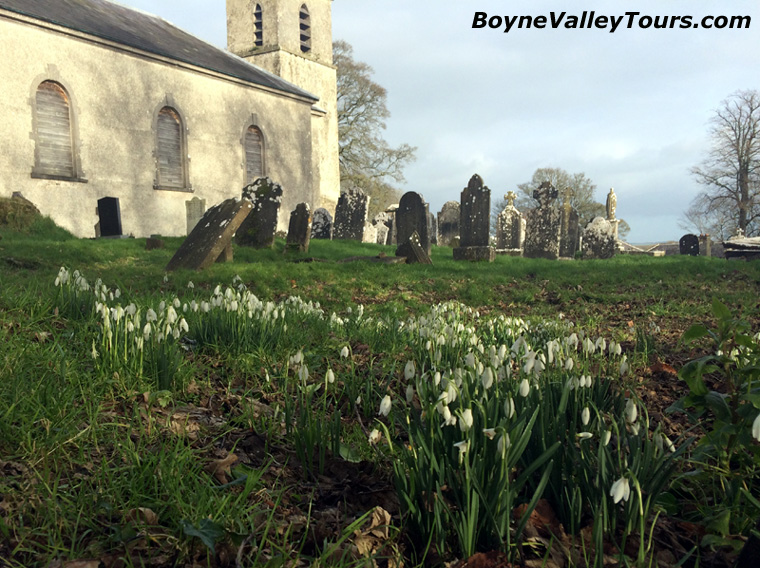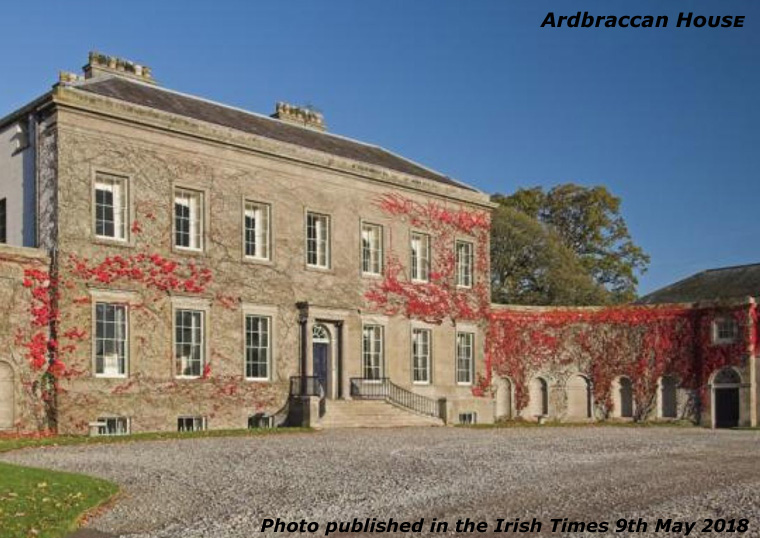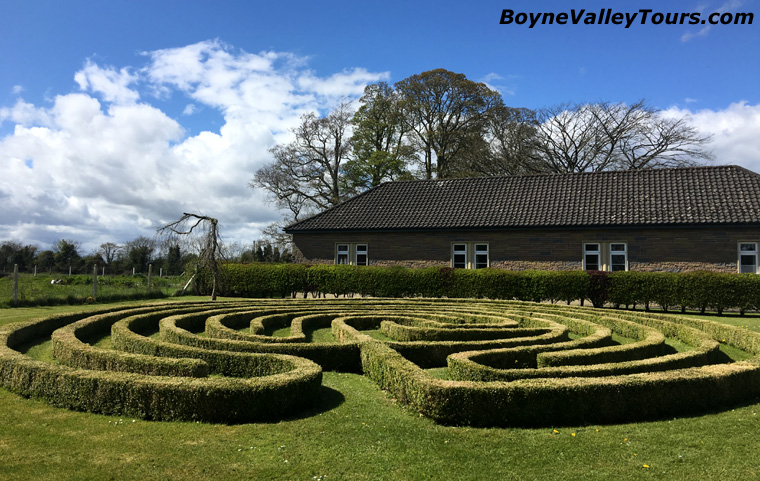Ardbraccan Church
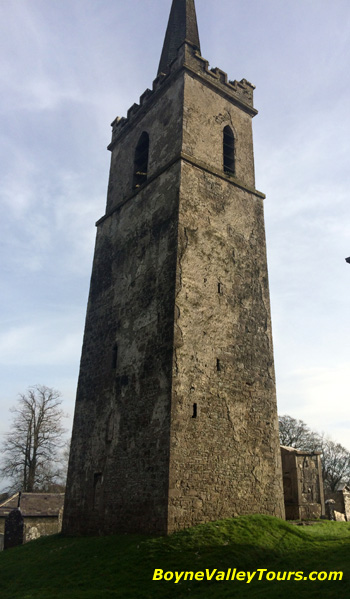 Ardbraccan
originated as a place of Christian worship under St. Braccan (St. Breacain) in the 7th century.
Ard in Irish means height, so the name Ardbraccan literally means the height or Hill of Braccan.
Ardbraccan
originated as a place of Christian worship under St. Braccan (St. Breacain) in the 7th century.
Ard in Irish means height, so the name Ardbraccan literally means the height or Hill of Braccan.
On this site a monastery and a succession of churches were built, the most famous was a large circular church known as the Stone House, which was burned to the ground by Viking attackers in the 12th century.
Ardbraccan was a bishopric or diocese up to the Synod of Kells in 1152, when it was united with Clonard, Trim, Dunshaughlin, Slane and Fore, forming the Diocese of Meath. Its importance was shown by the fact that the newly merged diocese's bishop lived in Ardbraccan.
When, in the aftermath of the crisis over Henry VIII's marriage to Catherine of Aragon, the Irish Church was ordered to formally break its link with the Roman Catholic Church to become the Church of Ireland, the Anglican or Church of Ireland Bishop of Meath continued to live in Ardbraccan in an estate attached to the main church.
In 1777 a new Church of Ireland church was erected on the site of the earlier church. The old church tower (photo to the right) predates the current church by hundreds of years.
The church remained in use until 1981 when it was deconsecrated, due to the dwindling size of the Church of Ireland community in Ardbraccan. The sourrounding cemetery is used for burials by both local Church of Ireland and Roman Catholic families, however there are no new plots allowed.
The Church of Ireland Bishop of Meath moved out of the 18th century bishop's palace in 1885 to live in a smaller mansion nearby, Bishopscourt. In 1958, the Church of Ireland bishop moved away from Ardbraccan altogether, with Bishopscourt being bought by a Catholic religious order, the Holy Ghost Fathers, who renamed in An Tobar (Irish for "The Well", linking it to an ancient well of St. Ultan at Ardbraccan). When the old church underwent some vandalism, its valuable stained glass windows were removed by the Church of Ireland and donated to An Tobar.
While the Church of Ireland community continued to use the name 'Ardbraccan' to refer to its parish, the nearby Roman Catholic parish in the 19th century opted to use a different name, Bohermeen, from the Irish An Bóthar Mín, meaning the smooth road, referring to a ancient road that passed through the area towards the Hill of Tara.
Ardbraccan - Excerpt from Discovering the Boyne Valley
Ardbraccan House was the seat of the diocese of Ardbraccan founded by St. Breaccan and St. Ultan. In the middle ages Ardbraccan became the seat for the Protestant bishops of Meath and a large house was erected with a chapel dedicated to St. Mary. The bishops of Meath were interred in the churchyard at Ardbraccan.The house was replaced by a Georgian building in the eighteenth century. The kitchen and stable wings were completed first in the mid 1730s and then the central block was erected about 1776. The two wings were designed by Richard Castle, the pre-eminent architect working in Ireland at the time while the central block was an amalgam of the designs of Thomas Cooley and James Wyatt, together with amateur Navan architect, the Rev. Daniel A. Beaufort. The house was constructed with limestone from the nearby White Quarry.
The house is set in mature pasture land with formal gardens and walled gardens. There is a courtyard of domestic and agricultural buildings to the north of the house. The farm and stables are joined to the house by a tunnel under the garden terrace. A dome-shaped icehouse, dating from about 1800, is located to the south of the outbuilding complex. A gable fronted gate lodge was constructed about 1776 when the main house was completed. Known as Ardbraccan House or Bishop's Palace the house was the residence of the bishops of Meath until 1885, after which it became a private residence.
In 1734 Bishop Arthur Price decided to replace the old Tudor house with a new residence and commissioned Richard Castle to prepare plans. Arthur Price had been vicar of Celbridge and resided at Oakley Park. Here his steward at Oakley Park was Richard Guinness, who was acclaimed for his brewing talents. Richard's son, Arthur, went on to establish the Guinness Brewery in Dublin in 1759.
While the new house was in the process of construction Price was elevated to Archbishop of Cashel and construction came to a halt. The kitchen wing was used as the bishop's residence for more than thirty years until Bishop Henry Maxwell decided to complete the building. Bishop Maxwell was a younger son of the 1st Lord Farnham of Cavan. James Wyatt, Thomas Cooley and Rev. Daniel Beaufort of Navan drew up plans and it would appear that while Wyatt's plans were used portions of Beaufort and Cooley also influenced the final house. Beaufort attended the laying of the foundation stone but had to leave early due to a toothache. Beaufort described the house as being ‘in a style of superior elegance, and yet with such simplicity as does equal honour to his lordship's taste and liberality.' Maxwell is said to have boasted that he would build a palace so grand that no scholar or tutor would dare live in it. Bishop Maxwell also constructed the nearby Ardbracan church about 1777.
The Bishops of Meath resided at Ardbraccan during the late eighteenth and first half of the nineteenth centuries. Rev. James Singer became bishop in 1852 but resided mostly in Dublin and the house at Ardbraccan was shut up in the 1860s. In 1876 Rev. William Plunket became bishop of Meath and he resolved to sell Ardbraccan as the costs of upkeep were too large for a now disestablished Church of Ireland. The bishops moved to a smaller house in the locality, Bishop's court, now An Tobar.
Bishop Plunkett sold the house in 1885 to Hugh Law, son of the Lord Chancellor of Ireland. At the time Fr. Kearney P.P. Bohermeen suggested purchasing the Bishop's Palace as a seminary but his bishop did not agree with the suggestion.
The house remained in the Law family until it passed by marriage to the Foster family. In 1985 Colonel Owen Foster sold Ardbraccan House to Tara Mines who used it as an occasional guest residence for visiting businessmen. The Fosters moved to the old schoolhouse at the entrance to the churchyard and were noted for their great care of the grounds of the church.
In the late 1990s the house was once again sold. David and Sarah Maher took up residence at Ardbraccan and began a four-year restoration of the house. In 2002 the restoration of Ardbraccan House won the Án Taisce ‘Best Restoration of a Private Building' award. The Meath Archaeological and Historical Society enjoyed a visit to the house a number of years ago.
St. Ultan's Well
St. Ultan's Well stands just outside the churchyard wall within the demesne of Ardbraccan House. One of the scared trees of Ireland, the Bile Torthain, was said to have stood over the well in pagan times. St. Ultan succeed St. Breccan as abbot of Ardbraccan. He collected material for a biography of St. Brigid, said to be his aunt. St. Ultan fed, clothed and educated 500 children orphaned by a yellow plague which carried off their parents. The Annals of Clonmacnoise placed St. Ultan's death in the year 653. In 1210 King John visited a place in Meath called Tiobraid Ultain.The well was quite large more than nine feet in diameter. Stations were held there until 1850. In the 1920s there was a revival of the pilgrimages to the well and in the 1950s there was a regular ceremony at the well. The pattern day was 1st September each year.
In the 1930s there was a pilgrimage to Saint Ultan's Well every year on the first Sunday in September and the Rosary is recited in Irish at the well. St. Ultan's well has cures for toothache and eye complaints. To be cured of a toothache a pilgrim took a drink of the water. For a sore eye a cloth was dipped in the water and then rubbed to the eye. To cure sore feet, they were washed in the water of the well.
St. Ultan was the inspiration for St. Ultan's Hospital for Infants in Dublin. Dr. Katheleen Lynn visited Meath and went on a pilgrimage to the Holy Well at Slane in 1919. St. Ultan's Hospital was founded in 1919 by Dr. Lynn and Madeleine ffrench Mullen. Every year the hospital organised a pilgrimage / picnic to Ardbraccan and St. Ultan's well. At the outset, only women staffed the hospital. Kathleen pioneered the use of the BCG vaccination over ten years before it was in general use in Ireland. She promoted the work of Maria Montessori who visited St Ultan's in 1934, and established a Montessori ward in the hospital. In 1929, Kathleen and St. Ultan's founded the world-famous Irish Sweepstakes alongside three other voluntary hospitals. St. Ultan's closed its doors for the last time in 1975, difficulties in getting funding made it impossible to continue. It is now a private clinic. Margaret Ó hÓgartaigh had an article on St. Ultan Hospital and its connections to Ardbraccan in the 2003 issue of Ríocht na Midhe.
Bishopscourt – An Tobar Ardbraccan
The Church of Ireland ceased being the state church in 1871. Up until then the church was supported by the State. We have no state church in Ireland today but some countries such as England and Finland still have state churches. Following dis-establishment of the church of Ireland in 1871 the diocese of Meath purchased Ardbraccan house and demesne to serve as home for the bishop of Meath. Ardbraccan had previously served as home of the bishops. In 1884 Bishop Plunket of Meath was appointed archbishop of Dublin. So many bishops had died during the nineteenth century that the position had became known as the “Dead See.” The running costs of the large house were too much and when Bishop Plunket was promoted to archbishop the diocese decided to sell the house, which they did with a lost of nearly 20% of the original purchase price. The diocese purchased the glebe-house of Ardbraccan, where the clergyman who served Ardbraccan lived and made that the home of the bishop. This house was re-named Bishopscourt.The parish of Ardbraccan was united with the parishes of Liscarton, Rataine, Churchtown, Martry and Clonmacduff. The glebe-house was situated about half a mile from the church. In 1837 the glebe comprised 33 acres of profitable land. In 1868 the rector J. Brownlow, was assisted by a curate who received £80 per annum. The Commission also noted that there were 267 members of the Established Church resident in the Union of Ardbraccan. A separate glebehouse for Ardbraccan parish was erected about 1890.
Bishopscourt House remained the residence of the bishops of Meath until it was sold in 1958. Bishopscourt was bought by a religious order, the Holy Ghost Fathers, who renamed in An Tobar, linking it to St. Ultan's Well at Ardbraccan. When the vacant Ardbraccan Church underwent some vandalism, one of its valuable stained glass windows were removed by the Church of Ireland and donated to An Tobar. The Ethel Rhind stained glass window, from 1933 depicting 'The Woman at the Well' was presented to the Holy Ghost Fathers and was restored by the Abbey Stained Glass Studio in Dublin. Ethel Rhind was a member of the group of stained glass artists called "An Tur Gloine", The Tower of Glass, who radically altered and improved standards of stained glass making in Ireland.
An Tobar retreat house was established in 1983 to provide a meeting place for those involved in work for peace and justice. There is a beautiful labyrinth of boxwood hedge alongside the Tobar building. There is also a lovely lakeside walk.
Ardbraccan limestone had been quarried in Ardbraccan Quarry which was also called the White Quarry, from the fourteenth century. It was best known in the eighteenth century but the limestone continued to be used in the twentieth century.
Ardbraccan Monastery
Ardbraccan means Breacan or Breacan's height or hill. The monastery at Ardbraccan was founded in the sixth or early seventh century. St. Brecan was the son of one of the leading noblemen of Munster - Eochaidh Balldearg, Prince of Thomond and he was grandon of Carthen Finn, first Christian ruler of Thomond. John Healy in "The History of the Diocese of Meath" says that Brecan was supposed to be the brother of St. Loman of the Britons who was St. Patrick's sister's son. This probably meant brother in Christ rather than an actual blood relation. St Loman came to Meath with St. Patrick and founded a church in Trim.St. Brecan went among the tribe Uí Borthim which inhabited Ardbraccan at the time and set up a monastery on a height. After governing Ardbraccan for a while he went to Connacht and founded a church on the "great Island of Arran" in Galway Bay. This church was named in his honour "Temple Braccan". He is said to have written prophesies regarding the future wars of Ireland and the coming of the English.
He died in 650 A.D. and his feast day is held on the 16th July. He was buried in his church on Aran. The tomb was locally known as St. Brecan's tomb. It was opened in the last century and a skeleton of the saint was found. St. Brecan handed over his monastery at Ardbraccan to St. Ultan.
St. Ultan was of the race Conchobair or Connor. He was supposed to have been related to St. Brigid on his mother's side. He became Abbot of Ardbraccan and first Bishop of the See of Ardbraccan. Ultan is said to be the author of the transactions of St. Brigid which were collected into one volume in alphabetical order. A hymn in Latin in St. Brigid's honour is also attributed to him as is an elaborate poem "Brigid be". He is also credited with being one of the first two men known to have concerned themselves with recording the acts of St. Patrick and is supposed to have written a life of St. Patrick. Some prophecies regarding the Norman invasion are also attributed to him. St. Ultan was supposed to have been the first winter swimmer in Ireland as he went and immersed himself in a river as penance.
Ultan is honoured as the patron saint of sick children. In the year 656 one of the ancient annals recall St Ultan, bishop of Ardbraccan, collected the infants who had been deprived of their mothers by a plague called Buidhe Chonnaill (Yellow Fever) and caused them to be fed with the milk of cows. This was the first hospital for orphans in Ireland. It is said that the population of the country at this time had become so dense that enough food could not be produced by the entire soil of the country and that apprehending famine the rulers invited the holy men and clergy to pray that the lower class or inferior multitude might be thinned lest everyone starve. However it did not quite work out that way - the two joint monarchs of Ireland, the Kings of Ulster and Munster, St. Fechin of Fore, St. Ronan, St. Aileran the wise, St. Cronan, St. Munchan, St. Ultan of Clonard and many other perished in this famine. A hospital named in Ultan's honour was founded in Dublin for sick children in the early part of twentieth century.
Dates of St Ultan's death differ - 653, 656, 660 and 662. He died on September 4th and a vigil was held up until the last century at a well at Ardbraccan. This well was in the demesne of the Protestant Bishop of Meath. It was circular and measured nine and a half feet in diameter. Ultan was succeeded as bishop by Tirechan. Tirechan wrote "Annotations on the Life of St. Patrick". These notes on the Acts of St. Patrick are to be found in the Book of Armagh and begin: "Tirecha, the Bishop, wrote these things either from word of mouth or from the book of Ultan of whom he was himself the scholar or disciple".
Ardbraccan flourished in Ireland's golden age when the country was known as "The Island of Saints and Scholars". Ardbraccan was a small monastic settlement by comparison to others but it was for five hundred years the centre of a diocese.
Ardbraccan lay on the routes of many maurading raiders. It was near to the Boyne and to Scandinavian Dublin thereby making it easy pickings for the Danes by boat or by land. The native Irish warring amongst themselves also helped destroy Ardbraccan.
In 886 the annals record the plundering of Ardbraccan, Donaghpatrick, Dulane and Glendalough by the Danes. More raids were made in 940, 949 and 992. In 1031 Ardbraccan Abbey was plundered and burnt by Sitric at the head of the Danes of Dublin and two hundred people or more were carried away as prisoners and as many more perished in the flames in the Daimhliag (the great church). In 1035 Ardbraccan was again plundered by the Danes.
The Danes eventually settled down peacefully but the native Irish continued the destruction of the monasteries. In 1069 an army led by Morrogh, son of Dermod destroyed Granard, Fore and Ardbraccan before Fechin slew him face to face. Morrogh was a Leinster man who had joined and recruited foreigners in his fight in the long running enmity between Meath and Leinster.
In 1109 Ardbraccan and its churches, together with the religious inhabitants, were burned by the men of Munster led by the O'Briens. In 1115 Ardbraccan was again burned by the men of Munster and the damhliag again destroyed. There were more raids and plundering in the years 1133 and 1136. In 1136 or 1156 Dermot Mac Murrough, the Danes of Dublin, and Donncha, son of Donnell O'Loughlin, made a raid of Meath and they plundered the country, both churches and territories, and they carried off the cows of Ardbraccan, Cill-Teltown, Downpatrick and some of the cows of the country in general.
The monks of Ardbraccan must have had great patience and sense of forgiveness as they rebuilt their church and buildings time after time. Education and learning continued during peaceful times. The learned Giolla Modhuda O'Cassidy was Abbot in the early part of the 12th century and he wrote many poems and histories. He wrote a long poem containing the history of Ireland from 428 to 1022 starting with the words "Eire Ogh, Innis Na Naomh" (Ireland Young, Island of Saints).
In 1166 the King of Ireland granted to the church of Ardraccan a parcel of land in perpetuity on the payment of three ounces of gold. This seems to have been recorded on the back of one of the pages in the Book of Kells. It specified the freedom of Ardbraccan from "Coigny", a tribute levied by the O'Kennellans, Lords of Navan, which they agreed to sell for 3 ounces of gold at the representations of Muirchertagh O'Loughlin, King of Ireland, Dermot O'Melaghlin, King of Meath and Gelasius, Archbishop of Armagh. Muirchertagh O'Loughlin, King of Aileach (Donegal), and High King of Ireland ruled for 10 years as High King but was a poor ruler - his sub-kings rose up and he was killed in a battle in 1166, the same year he made the grant at Ardbraccan. This grant of land may have been a last ditch attempt to save the monastery of Ardbraccan as it has suffered greatly from the constant raids. In 1170 it is recorded that the steeple of the Abbey of Ardbraccan fell. Ardbraccan gradually faded away.
During Ardbraccan's heyday it was the centre of one of the eight dioceses that existed in Meath. The others were Clonard, Duleek, Kells Trim, Slane, Fore and Dunshaughlin. At the Synod of Kells in 1152 these were organised into three dioceses - Clonard, Kells and Duleek for East Meath. After the Normans came these two dioceses were united into the Bishopric of Meath.
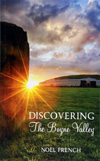 Discovering the Boyne Valley by Noel French. The Boyne Valley is a place of history, myths and legends.
This rich valley is home to some of Ireland's most famous heritage sites and monuments
- Tara,
Newgrange,
Kells and the Battle of the Boyne site - but there are many others including
Trim Castle,
Loughcrew,
Monasterboice
and Mellifont
which are major attractions in their own right. A landscape of passage tombs,
sacred hills, monastic ruins, bloody battlefields and heritage towns - no wonder the Boyne Valley is
considered the birthplace of Ireland's Ancient East.
Purchase at Amazon.com or
Amazon.co.uk
Discovering the Boyne Valley by Noel French. The Boyne Valley is a place of history, myths and legends.
This rich valley is home to some of Ireland's most famous heritage sites and monuments
- Tara,
Newgrange,
Kells and the Battle of the Boyne site - but there are many others including
Trim Castle,
Loughcrew,
Monasterboice
and Mellifont
which are major attractions in their own right. A landscape of passage tombs,
sacred hills, monastic ruins, bloody battlefields and heritage towns - no wonder the Boyne Valley is
considered the birthplace of Ireland's Ancient East.
Purchase at Amazon.com or
Amazon.co.uk
Boyne Valley Tours Privacy, Terms and Conditions

